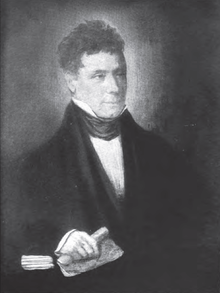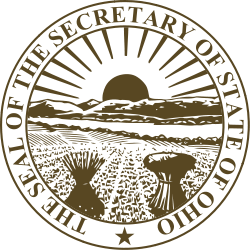William Creighton, Jr.
| William Creighton | |
|---|---|
 | |
| Member of the U.S. House of Representatives from Ohio's 3rd district | |
|
In office March 4, 1813 – March 3, 1817 | |
| Preceded by | new seat |
| Succeeded by | Levi Barber |
| Member of the U.S. House of Representatives from Ohio's 6th district | |
|
In office March 4, 1827 – before November 1, 1828 | |
| Preceded by | John Thomson |
| Succeeded by | Francis Swaine Muhlenberg |
|
In office March 4, 1829 – March 3, 1833 | |
| Preceded by | Francis Swaine Muhlenberg |
| Succeeded by | Samuel Finley Vinton |
| first Ohio Secretary of State | |
|
In office March 1803 – December 1808 | |
| Preceded by | new office |
| Succeeded by | Jeremiah McLene |
| United States District Court for the District of Ohio | |
|
In office November 1, 1828 – February 16, 1829 | |
| Appointed by | John Quincy Adams |
| Preceded by | Charles Willing Byrd |
| Succeeded by | John Wilson Campbell |
| Personal details | |
| Born |
October 29, 1778 Berkeley County, Virginia |
| Died |
October 8, 1851 (aged 72) Chillicothe, Ohio |
| Resting place | Grandview Cemetery |
| Political party | Democratic-Republican |
| Spouse(s) | Eliza Meade |
| Children | two |
| Alma mater | Dickinson College |
William Creighton (October 29, 1778 – October 8, 1851) was an attorney, banker and legislator. Creighton was Ohio’s first Secretary of State and designer of the Great Seal of Ohio.
Biography
Creighton was born in Berkeley County, Virginia, the son of Robert and Margaret Creighton. William graduated in 1795 from Dickinson College in Carlisle, Pennsylvania. He read law in 1798 and was admitted to the bar in Ross County, Ohio, in June 1799. He began his practice in Chillicothe.
Creighton always signed his name "William Creighton, Jr." because he had an elder cousin of the same name who also lived in Ross County, Ohio. His elder cousin, who styled himself William Creighton, Sr., was also politically active, holding seats in the Ohio House (1803 and 1831) and Ohio Senate (1813–14), and appointed United States postmaster in Ross County from 1815 to 1831.
Arthur St. Clair, governor of the Northwest Territory opposed the admission of Ohio as a state and proposed to divide the territory up in such a way as to preclude Ohio’s eligibility for admission. Suspecting that St. Clair might attempt some sort of coup by means of the legislature, the members rushed through the organization and Constitution in order to forestall his opposition. Although the 1802 Constitution was not presented to the voters for approval, Creighton wrote to his friend Thomas Worthington a few days after the territorial legislature’s adjournment, "The Sovereign people continue remarkably quiet. I must relate to you an anecdote of Daniel Hamilton. In this place the other day he was asked how the people of his neighborhood like the Constitution? He said they did not like it at all because it had no pictures in it."
Political success in Ohio affairs
Creighton was Ohio’s first Secretary of State, serving from 1803 until 1808. For some time after the admission of Ohio into the Union, William Creighton used his private seal for state papers. Early in the spring of 1803, Creighton, Governor Edward Tiffin and U. S. Senator Thomas Worthington met at the home of Worthington to discuss state affairs. They talked through the night, considering, among other things, the matter of a state seal, which was required by the state Constitution. Before separating, they stood on the lawn just as the sun rose slowly behind the Mount Logan Range. Creighton is said to have remarked, “The rising sun of the new state!” He then made the suggestion for the great seal of Ohio.
One of the most pressing needs of the young state was for the enactment of a systematic criminal code. The legislature of the spring of 1803 had postponed the matter by providing that the Territorial code should remain in force until it was superseded. Following the recommendation of Governor Tiffin, a committee of the General Assembly of 1804-05 undertook the compilation of a criminal code. Secretary of State Creighton acted as clerk of this committee and contributed substantially to the work of the codifiers.
In February 1805, William Creighton was appointed a Trustee of Ohio University in Athens, Ohio. He served until 1808.
In 1807, William Creighton was appointed by the Ohio legislature as a commissioner, with his brother-in-law Nathaniel Massie, Duncan McArthur and six others, to supervise a lottery to raise $12,000 for the improvement of the banks of the Scioto River at Chillicothe and to establish a ferry across the river at that point.
In August 1807, the Supreme Court of Ohio ruled in Rutherford v. M'Faddon that a law passed by the legislature was unconstitutional. Chief Justice Samuel Huntington and Judge George Tod had written the opinions supporting the ruling, essentially a restatement of the federal holding of Marbury v. Madison. The Ohio house impeached Judge Tod on the grounds that he was usurping the power of the legislature. Huntington, who had run for governor, was spared impeachment out of respect for his office) At his Senate trial, Judge Tod was defended by William Creighton, Henry Brush and two others. The vote for conviction was one vote shy of the two-thirds required.
Creighton was elected Sheriff of Ross County in 1808, and served until 1812. Creighton was elected a member of the Ohio House of Representatives from Ross County in 1810.
Congressional and judicial service
In May 1813, Creighton was elected as a Democratic-Republican from Ohio's 3rd congressional district to the Thirteenth United States Congress to fill the vacancy caused by the resignation of Duncan McArthur. Creighton was reelected to a full term in the Fourteenth Congress. He was unsuccessful in his bid for election to the United States Senate in 1816.
Creighton returned to his law practice in Chillicothe, and became partners with William Key Bond.
Creighton became president of the branch of the Bank of the United States at Chillicothe from its opening in 1817 until its dissolution by Jackson's veto around 1829. Ohio proposed to tax the bank, but the bank had obtained an injunction on the grounds of federal sovereignty. However, the state auditor hired a man to obtain by whatever means he could the $100,000 the state claimed in tax. In what amounted to a daylight robbery — although he presented a warrant from the auditor — the man jumped over the counter and took the money from the vault. Bank president Creighton protested there was an injunction but to no avail.
In 1820, William Creighton was elected Master of Scioto Lodge No. 6 of Free and Accepted Masons.
In the election of 1826, Creighton was elected to Congress from Ohio's 6th congressional district for the Twentieth Congress. He resigned the position when he received a recess appointment by President John Quincy Adams on November 1, 1828, to a seat on the Federal bench in the United States District Court for the District of Ohio. The judgeship had been vacated by his brother-in-law, Charles Willing Byrd. Adams nominated Creighton on December 11, 1828 but the nomination was not confirmed by the United States Senate, which passed a resolution that it was "not expedient to fill the vacancy at the present session of Congress," and his service terminated on February 16, 1829.
Creighton returned to Congress from the 6th district, elected in 1828 as an Anti-Jacksonian to the Twenty-first and re-elected in 1830 to the Twenty-second Congresses. He was not a candidate for re-nomination in 1832.
Return to Chillicothe
Creighton returned to Chillicothe and resumed the practice of law. Judge John L. Green became his partner after 1838. Creighton became an ardent Whig after the formation of that party and was particularly devoted to the fortunes of Henry Clay, whom Creighton entertained in his home.
Family life
William Creighton married Eliza Meade, probably in Jessamine County, Kentucky in September 1805. They had two daughters, Susan and Sarah.
Eliza Meade’s sisters were married to Nathaniel Massie and Charles Willing Byrd.
Death
William Creighton died in Chillicothe in 1851 and was interred in Grandview Cemetery.[1]
Further reading
- A compilation of laws, treaties, resolutions, and ordinances of the general and state governments which relate to lands in the state of Ohio. Columbus: Printed by G. Nashee, state printer, 1825, 534 pgs.
- History of lower Scioto Valley, Ohio. Chicago: Interstate Publishing Co., 1884, 911 pgs.
- Taylor, William Alexander. Ohio statesmen and annals of progress: from the year 1788 to the year 1900. Columbus, Ohio: Press of the Westbote Co., state printers, 1899 (©1898), 458 pgs.
- Gilkey, Elliot Howard The Ohio hundred year book: a hand-book of the public men and public institutions of Ohio, from the formation of the Northwest Territory (1787) to July 1, 1901. Columbus: F.J. Heer, state printer, 1901, 779 pgs.
- Bennett, Henry Holcomb, The county of Ross: a history of Ross County, Ohio. Madison, Wis.: S. A. Brant, 1902, 729 pgs.
- Galbreath, C. B. Ohio emblems and monuments: seals, flag, flower, buckeye, jewels, McKinley Memorial Columbus, Ohio: Board of Library Commissioners, 1907?, 28 pgs.
- Utter, William T. The frontier state from 1803 to 1825. Columbus, Ohio: Ohio State Archaeological and Historical Society, 1942, 468 pgs.
- A Standard history of Ross County, Ohio. Chicago: Lewis Pub. Co. 1917, 1006 pgs.
- Johnson, Ross B., West Virginia Estate Settlements, Berkeley County from 1722 to 1815, West Virginia History Vol XVII-XXIV, 1955
References
- ↑ "Grandview Cemetery". Grandview Cemetery. Retrieved July 29, 2012.
External links
- United States Congress. "William Creighton, Jr. (id: C000902)". Biographical Directory of the United States Congress.
- William Creighton, Jr. at the Biographical Directory of Federal Judges, a public domain publication of the Federal Judicial Center.

- William Creighton, Jr. at Ohio History Central
- William Creighton, Jr. at Find a Grave
| Offices and distinctions | ||||||||||||||||||||||||||||||||||||
|---|---|---|---|---|---|---|---|---|---|---|---|---|---|---|---|---|---|---|---|---|---|---|---|---|---|---|---|---|---|---|---|---|---|---|---|---|
| ||||||||||||||||||||||||||||||||||||

